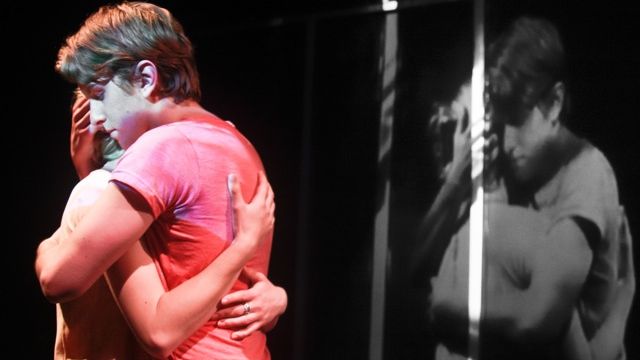Our Shadows Pass Only Once
Told entirely in interior monologue, this poetic and abstract work explores emotions within two failing relationships. With deliberately slow, flowing movement and innovative use of live video, it’s mesmerizingly compelling.
Author David Temme seems to be deliberately leaving the narrative wide open, allowing the audience to guess what is actually happening between the two couples—perhaps the external events are irrelevant and only the emotional reality is important. The dialogue seems to spring from the point that the words form within the character’s minds, almost before they are conscious of them. As such there’s a rawness to what is being said. The two female characters are needy—Sarah Nathan-Truesdale’s character has a passive fragility which invites abuse, while Caroline Simone O’Brien’s character is possibly on the verge of nervous breakdown, and gives such contradictory signals that she drives her partner to despair. The male characters are simpler: both are bewildered, but Josh Wiseman’s character is active and responds with violence, while Raoul Craemer’s character is passive, escaping into heartbreaking fantasies of the happy family life he’d like to have with his partner. Given each couples’ interpersonal dynamic, the play is then structured into riffs on 15 different themes.
This is all made so much more compelling by the clever use of black and white video images of the live action projected onto the back of the theatre, giving a filmic quality. The stage direction has obviously been given careful thought, since all the pictures are carefully composed and use existing elements of the theatre. For instance, the play opens with the four characters seated, lined up against the wall. In the larger than life video image, they’re each projected separately into partitions that exist already on the bare back wall (including a door and Exit sign). Sometimes they’re visual puns, at other times close ups of characters’ faces to emphasise their emotions. The audio design is haunting and slightly discomforting.
The play is not always easy to watch, delving as it does into dark emotional territory and without a narrative framework to give sense and context. However, it’s clever and creative, very well performed, with high production values and the feel of an audio-visual modern artwork, and definitely worth the effort.
Cathy Bannister
Subscribe to our E-Newsletter, buy our latest print edition or find a Performing Arts book at Book Nook.

